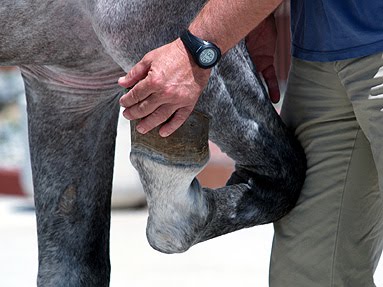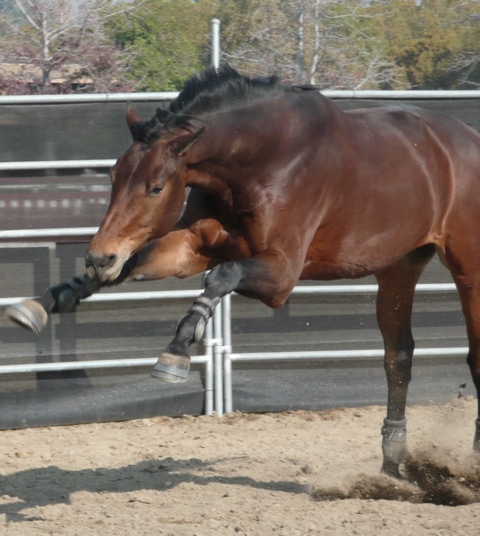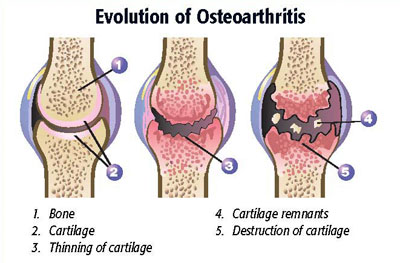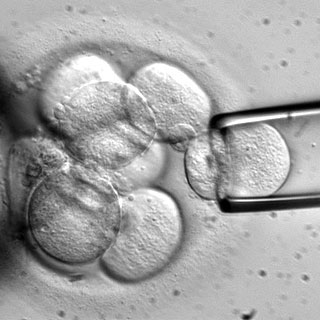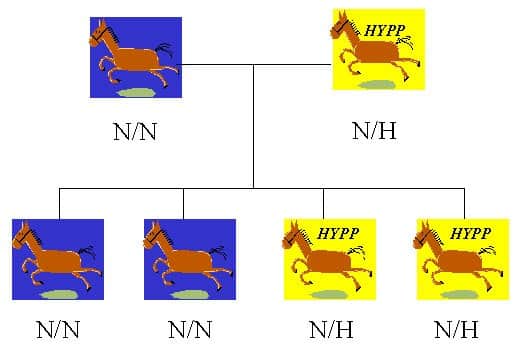FORELIMB FLEXION TESTS, COMMONLY USED IN EVALUATION OF THE HORSE’S LOWER LIMBS, ARE POOR TESTS FOR LOCALIZING PROBLEMS, AND CAN’T PREDICT PROBLEMS OCCURRING IN THE FUTURE – read the landmark study by Dr. Ramey, below
Prospective Evaluation of Forelimb Flexion Tests in Practice: Clinical Response, Radiographic Correlations, and Predictive Value for Future Lameness.
[Prospective Evaluation of Forelimb Flexion Tests PDF]
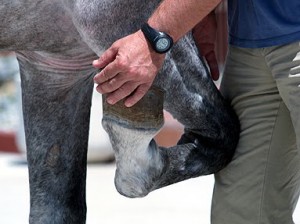 Many otherwise normal horses demonstrate a positive response to forelimb flexion tests. The response varies directly with the pressure applied to the limb. A positive response to flexion does not correlate with future lameness or lower limb radiographic abnormalities. Reliance on this test to diagnose sub clinical lameness or predict future problems seems unwise.
Many otherwise normal horses demonstrate a positive response to forelimb flexion tests. The response varies directly with the pressure applied to the limb. A positive response to flexion does not correlate with future lameness or lower limb radiographic abnormalities. Reliance on this test to diagnose sub clinical lameness or predict future problems seems unwise.
Forelimb flexion tests were described in the Swedish veterinary literature as early as 1923. They appear to have become an integral part of the evaluation of the lame horse. In addition, forelimb flexion tests appear to be routinely included in pre-purchase evaluations of the horse.
In a forelimb flexion test, various joints and softtissue structures of the lower limb (from the carpus distally) are held in flexion for a short period of time. Afterward, the horse is immediately trotted off and observed for signs of lameness.
In my study, fifty horses (100 legs) of various breeds, ages, sex, and occupation were examined for this study. Breeds, ages, sex, and occupations of the horses examined included a wide variety of pleasure and performance horses and were a representative sampling of the horses treated in the author’s practice.
A lameness history of all horses was obtained. All horses were examined on hard ground at the trot in hand prior to inclusion in the study and were palpated for abnormal swellings or areas of soreness. Any potential candidate for the study showing signs of clinical lameness or demonstrating gross physical abnormalities was rejected. All horses were reevaluated at the trot in hand on hard ground and the lameness history was updated 60 days after the initial evaluation. If an individual horse incurred some lameness in the 60-day period following the initial examination, this was correlated with clinical, flexion test, and radiographic findings.
This study suggests that reliance on forelimb flexion tests for a diagnosis of impending lameness or to detect subclinical problems that may adversely affect a purchase decision may not be warranted. Furthermore, a positive response to forelimb flexion does not correlate well with radiographic abnormalities of the lower limbs.
Flexion tests appear to also have no predictive value for the occurrence of forelimb lameness in this study. Of the 50 horses initially included in this study, seven were evaluated for lameness in the 60-day period following the initial evaluation. However, none of the lameness occurred in areas that could have been reasonably predicted by forelimb flexion.
Some owners and trainers apparently feel that there is a potential for hurting a horse with forelimb flexion tests. They are concerned that by flexing the joint, one could apply sufficient stress to the tissues to injure them. No signs of such a problem were seen in this study. Nor were signs of injury caused by flexion tests seen in the Belgian study, in which horses were subjected to as many as six flexion tests a week.
Conclusions
The response to forelimb flexion tests must be interpreted in light of clinical findings such as joint effusion, reduced limb or joint flexibility, pain to palpation, or clinical lameness in the limb that demonstrates the positive response. Radiographic findings of such things as osteoarthritis that correlate with a positive response to forelimb flexion may add some significance to a flexion test as well, particularly if there is concurrent clinical lameness. However, this study also suggests that many radiographic abnormalities occur in clinically sound horses. Studies documenting radiographic changes that occur in sound horses or that follow the progression of radiographic lesions over time are lacking and are sorely needed.
It is apparent from this and other studies that many otherwise normal horses will demonstrate a positive response to forelimb flexion tests and that the response varies directly with the force applied to the limb. Reliance on this test to detect subclinical lameness or predict future problems seems, at best, unwise.

